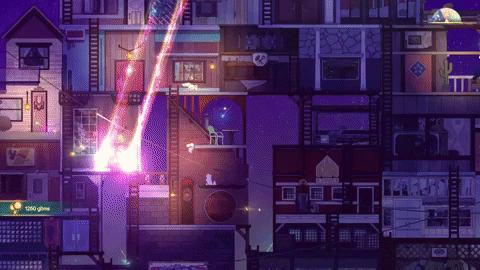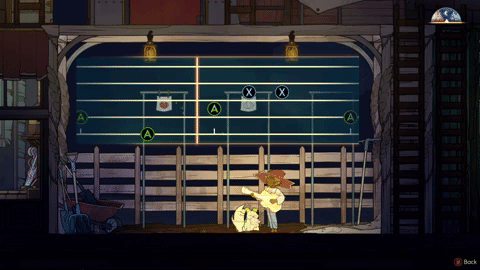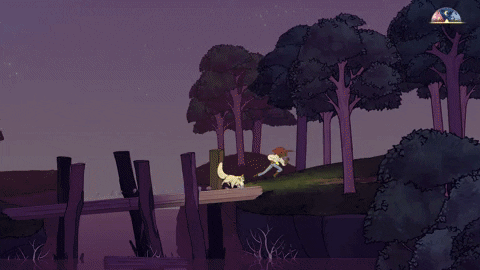Looking for the Quick Review?
I installed Spiritfarer on a whim, expecting it to be a brief diversion from the two or three games I’ve been focused on. Instead, it took up the vast majority of my gaming time over the past two weeks and became one of my favorite video game experiences of the year.

Spiritfarer tells the tale of Stella, a young girl new to the underworld and designated successor of Charon, the ferryman in charge of transporting souls from the world of the living to the realm of the dead. In Stella’s shoes, alongside her helpful cat Daffodil, you inherit a boat, the Spiritfarer, and the everlight, an orb of otherworldly energy/Swiss army knife useful for collecting resources and navigating the afterlife. Your job, per Charon’s recruitment ad, is to traverse the open sea, collecting souls, building relationships with them, and helping them to a place of comfort before ultimately acting as their guide to the Everdoor where death awaits.

Before I’d met my first soul, I’d already been taken in by the art style and atmosphere of the game. Its picture-book aesthetic and whimsical style aid in masking the deeper realities of its intense story and mood. Almost all of the game’s art assets feel hand-drawn, and those that don’t are spectacular in their own way; the sun casts vibrant, orange rays on the Spiritfarer’s decks as it sets; multicolored comets fall from the sky in a barrage of prismatic radiance in a way that legitimately inspires awe. Behind it all, an upbeat musical medley accompanies the game’s more typical, happier moments, but gives way to a much slower, serene soundtrack during its more serious asides.

But even when they’re overshadowed in playtime by the happy, adorable backdrop of Spiritfarer’s world, those quiet, deep moments are the defining chapters of the game. Spiritfarer supplied me with a cute, vivid seascape to explore, but after the first time I dutifully boarded a gondola with a determined soul on her way to finality, there was no doubting what this game was about and what it was going to feel like. Once that first voyage to the Everdoor is complete, it’s impossible to look at Spiritfarer as an upbeat fantasy experience any longer; the game readily displays its punches: it’s going to be sad as hell. Its masterpiece is in making you forget that, even for a moment.

Even once I’d come to terms with the type of game Spiritfarer was going to be thematically, I don’t think I really knew what to expect going forward. My suspicion was that the game would offer me cute stories about newly-deceased spirits (in anthropomorphic animal bodies) coming to terms with their deaths, accepting them, and moving on peacefully, having gained newfound perspective in the afterlife. To my surprise, Spiritfarer isn’t that. Spirits have differing reactions to their deaths; sometimes they pass on in brave, tranquil silence, but sometimes they’re still upset about having died at all. Some feel like they wasted their time among the living; they’re cognizant of mistakes they’ve made, and they don’t leave their earthen memories and biases behind. Some spirits resolve to enter the Everdoor having done little to no introspection at all, and phase into afterlife as bitter as they were when they died.

It’s jarring at first, and sometimes I think I’d prefer if the game followed my first course of suspicion and offered me each story in a neatly-wrapped box with a big ol’ bow of closure. But it’s silly of me to think that it not following that path is a failure on the part of the developer. More likely, I think, Spiritfarer isn’t about that sense of closure; it’s about death, in the gritty, real, and unfortunate skin we sometimes refuse to see it in. The story I expected to see, the one I wanted to see, sugarcoats the concept death; no matter how much we mess up here and now, there’s comfort in the end. But as open as Spiritfarer is to viewing the brighter, healthier side of death, it’s not interested in lying (insofar as an afterlife of pseudo-furries living together on a boat is “the truth”). Each departure in Spiritfarer left me with a different emotional response instead of the standard bittersweet that my preferred story probably would have. It wasn’t the story I expected, but it was one I came to really enjoy.

Similarly, the characters I met on my voyage didn’t match my expectations either. Each soul you rescue is a cute, anthropomorphic animal (except one — no spoilers) bearing the personality and story of a recently-deceased person. Even with the game’s focus on mortality, it was all too easy for me to underestimate the reality of these characters. They’re fleshed out, realistic, and… kinda gritty, at least as fleshed out and realistic as you can get with the game’s relatively short story. Some of them are the kind, heartfelt souls I’d been prepared to meet on my journey, but others are brash, rude, and mean, apparently unfazed by their recent deaths, or maybe further embittered by them. I can honestly say I felt something when each soul left the Spiritfarer forever, but I can’t say I wasn’t initially happy to let some of them go. Even so, some of the saddest paths to departure are had by those with the kindest hearts, a reality that hit hard early on.

Beneath the gargantuan cloud that is the game’s overarching story and atmosphere, its gameplay is pretty straightforward. It’s a two-dimensional exploration-adventure game with survival elements and at least a hint of inspiration from the Metroidvania genre. Using the Spiritfarer to ferry you and your crew from place to place in the fairly expansive nautical world, you’ll also need to upgrade its decks with housing for souls, farms to keep them fed, and crafting stations to produce building materials, home improvements, and pies. Building up from a barebones garbage barge with a house or two to a colossal juggernaut bearing an OSHA-defiant, Kowloon Walled City-reminiscent mess of homes, workshops, and animal pens illustrates a theme of growth. It’s also just fun to upgrade stuff.

Some of Spiritfarer’s core gameplay strengths come from its world and a few of its resource-gathering minigames. In exploring the many islands of the open sea, you’ll come across areas gated by limited mobility; pathways too high up, doors under lock and key, or surfaces just a little too far to jump to. As you forge your way through the game’s story and aid the souls who call your ship home, they’ll reward you with tokens that can be exchanged at shrines for abilities that enhance mobility, unlocking previously unexplorable areas. Similarly, at the beginning of the game, large sections of the sea are roped off by ice floes, jagged rocks, and deep, impenetrable fog that all require Spiritfarer upgrades to navigate through. Advancement in the game feels like real progress, and additional exploration opportunities reward participation and growth.

Getting to the minigames, just about every resource gathered in Spiritfarer comes in the form of a short, microgame experience, from lightning in a bottle collected by quickly hopping beneath visual indicators of gathering lightning to insect-woven fibers gathered by returning rambunctious bug-babies to their worried mother. These semi-spontaneous gathering events are as fun as they are varied, offering a neat little twist to the experience of navigating through the open ocean.

In my experience, though, some of the activities required to craft the resources wax tedious with time. Farming in the game can be fun, and the neat Guitar Hero-esque minigame that encourages plants to grow faster is enjoyable, but the sheer amount of food-growing necessary to move forward in the game means there’s a good chance you’ll get tired of doing it. I loved at first how each of the game’s crafting and gathering mechanics came complete with cute little animations, but by its end I was more than tired of waiting for Stella to finish watering or harvesting the crops. A few of the game’s other crafting experiences mimic this semi-tedious grind; crushing rocks and smithing alloys doesn’t carry forth the same fun as weaving fabrics at the loom or refining wood at the sawmill. Still, as cumbersome as these became, they weren’t overwhelming, and players less focused on optimization might find them to be hardly tedious at all.

In the same vein, the game’s cooking mechanic, which offers a set of interesting challenges in the form of determining what ingredients to combine to create each dish and attempting to artfully pair dishes to the souls who might enjoy (or dislike) them. I didn’t mind cooking and feeding the ship’s souls for most of the game, but toward the end as my boat’s population increased and my responsibilities followed suit, remembering to grow, cook, and maintain stock of each individual’s favorite foods became a bit of a chore.

The only other complaints I can muster for the game are on the level of nitpicking. The later portion of the game focuses significantly more heavily on the survival/crafting aspect than the earlier chapters, and while I found the game’s music to match its multitude of themes perfectly, there’s one track that plays when you’re at one of the game’s many fast travel hubs — it’s not a bad song, just loud and short. If you stop there too late at night, you’ll have to remain in place while you sleep and then navigate away in the morning. Through that whole montage, there’s this blaring circus theme in the background. Again, the song itself is fine, but it’s so short that you’ll be hearing it loop a few times while you pass through the midnight hours into the morning. Minor nitpick, but don’t tell me that while the drama is underway.
Beyond that, my most major disappointment was one small segment of the story. I’ve purposefully kept myself from viewing too much discussion online so as to not taint this review, but I know others will join me in this response. No spoilers, but at one point, one of your gathered souls (and easily my favorite) disappears without notice, never to return. Everyone else you get to usher through the Everdoor, but not this one. Big bummer.

Nitpicks and gameplay quirks aside, I adored my time with Spiritfarer. Having played it for free through my Game Pass subscription, I feel I’ve robbed its developers blind. The art and music are beautiful. The characters are captivating and real, and the gameplay kept me gripped for hours. Spiritfarer is, thematically, an undeniably dark and bittersweet story, but it’s a story I don’t regret having participated in. I knew each soul’s departure would take something from me, but I forged on, both because the game was fun and because I knew the story would be one worth hearing. On that front, I have no complaints.
It’s a crowning feature for a game to be fun, but a much more tremendous feat for it to accomplish that while making the player feel something. There are a lot of games I’ve enjoyed this year, and I’ll remember them for that. But the lasting memory of Spiritfarer beats out everything else as something deeper, something more emotional, something more innately human. It’s a great game, and I can’t recommend it enough.
Quick Review

Game: Spiritfarer
Developer: Thunder Lotus Games
Published by: Thunder Lotus Games
Available for: Nintendo Switch, Playstation 4, Stadia, Windows PC, Xbox One
CONTENT
Microtransactions: None
Tedium: Some – Regularly-necessary resource gathering tasks become cumbersome over time
Violence: None Depicted; Referred to in text
Content: Tobacco use, mild language
FEATURES
- Narrative focus
- Adventure gameplay with Metroidvania-inspired gated exploration
- Survival-esque building, resource gathering, and hunger
- Gradual upgrade mechanics

WHAT I LIKED
- Heartfelt, meaningful story
- Beautifully-illustrated world
- Fun, engaging characters
- Upgrade & progression systems
CONCERNS
- Some survival tasks become tedious over time
- Gameplay focus shifts more heavily toward crafting in the final third
- Not the happy, upbeat game it looks like
- Might make you cry

WHO’S IT FOR?
If you’re looking for a game with a deep, thematic narrative and don’t mind pushing your way through some survival-focused minigames on the way, Spiritfarer is a beautiful story worth experiencing. On the other hand, if sad stories aren’t your thing, or if a little bit of tedium is too much tedium in your book, this one might not be for you.
STATISTICS
Playtime statistics were unavailable at the time of writing this review. Check out the game’s Steamspy page to see if they’ve been added.

